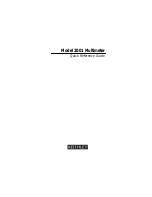
Section 8: TSP command reference
Model DMM7510 7½ Digit Graphical Sampling Multimeter Reference Manual
8-2
DMM7510-901-01 Rev. B / May 2015
Parameters for functions
All functions must have a set of parentheses
()
immediately following the function. If there are
parameters for the function, they are placed between the parentheses. The parentheses are required
even when no parameters are specified.
The following example shows the
beeper.beep()
function, where
2
is the duration in seconds and
2400
is the frequency. Note that the parameters are inside the parentheses:
beeper.beep(2, 2400)
The command below resets commands to their default values (no parameters are needed):
reset()
Multiple parameters
Multiple parameters must be separated by commas.
For example, the following commands set the beeper to emit a double-beep at 2400 Hz, with a beep
sequence of 0.5 s on, a delay of 0.25 s, and then 0.5 s on:
beeper.beep(0.5, 2400)
delay(0.250)
beeper.beep(0.5, 2400)
Time and date values
Time and date values are represented as the number of seconds since some base. The time bases
are:
•
UTC 12:00 am Jan 1, 1970:
Some examples of UTC time are reading buffer timestamps,
calibration adjustment and verification dates, and the value returned by
os.time()
.
•
Event:
Time referenced to an event, such as the first reading stored in a reading buffer.
Local and remote control
The instrument can be controlled locally or remotely.
When the instrument is controlled locally, you operate the instrument using the front-panel controls.
When it is controlled remotely, you operate the instrument through a controller (usually a computer).
When the instrument is first powered on, it is controlled locally.
The type of control is displayed on the front panel. When the instrument is in local control, the
REMOTE LED indicator in the upper right corner is off and the control indicator on the upper left of
the screen shows Local.
When the instrument is in remote control, the front-panel REMOTE LED indicator is on and the
control indicator at the top left of the screen shows the type of communication interface.
















































